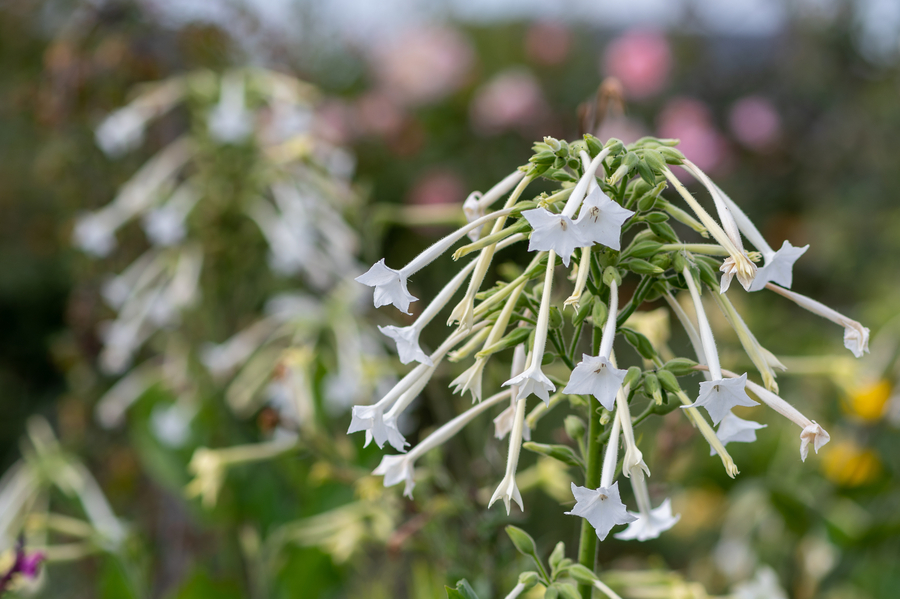The beauty of flowering annual and perennial plants is incredible and mesmerizing.
They offer glossy green leaves and flowers in brilliant colors from gold to purple to mauve. This guide will list all the magnificent flowers that start with T, and give you gardening details, should you want to grow them.
List of Flowers that Start with T
Perennial Flowers that Start with T
- Tiger lily (Lilium tigrinum)
- Tithonia rotundifolia (Mexican sunflower)
- Trachelium caeruleum (Blue throatwort)
- Trillium grandiflorum (Great white trillium)
- Triteleia laxa (Triplet lily)
- Thymus vulgaris (Thyme)
- Tigridia pavonia (Tiger flower)
- Toadflax (Linaria spp.)
- Trycyrtis spp. (Toad lily)
Annual Flowers that Start with T
- Thunbergia spp. (Bush clock vine)
- Torenia plant (Torenia spp.)
- Tobacco plant (Nicotiana benthamiana)
Perennial Flowers that Start with T
1. Tiger lily (Lilium tigrinum)
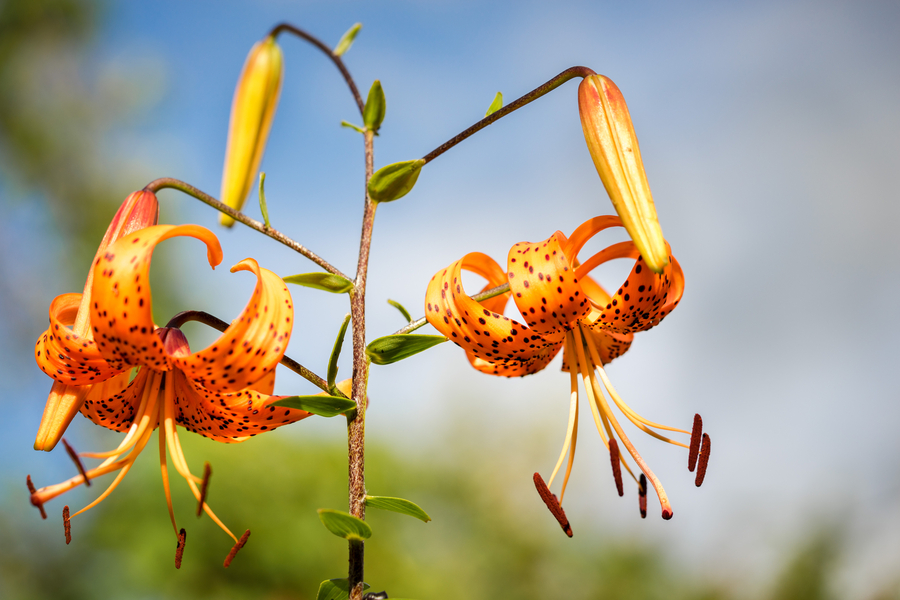
| Common name | Tiger lily |
| Botanical name | Lilium tigrinum (synonymous with Lilium lancifolium) |
| Family | Liliaceae |
| Mature size | 3-5 feet tall and 7-8 inches wide |
| Plant type | Perennial herb |
| Native range | Russia, Japan, Tibet, Korea |
| USDA hardiness zone | 3a, 3b, 4a, 4b, 5a, 5b, 6a, 6b, 7a, 7b, 8a, 8b, 9a, 9b |
| Growth habit | Underground bulb |
| Growth rate | Slow to moderate |
Tiger lilies are herbaceous perennials with brightly colored flowers. Their blooms boast bright orange-colored petals with distinct black or crimson marks, resembling tiger skin.
These plants bloom prolifically in mid to late summer based on growing conditions and climate. They can thrive in any soil type and sunlight, including dry or moist soil and full or partial sun.
Note: In Chinese culture, tiger lilies are associated with wealth, good luck, and prosperity, while in various floral decorations, they represent pride and prosperity.
2. Tithonia rotundifolia (Mexican sunflower)
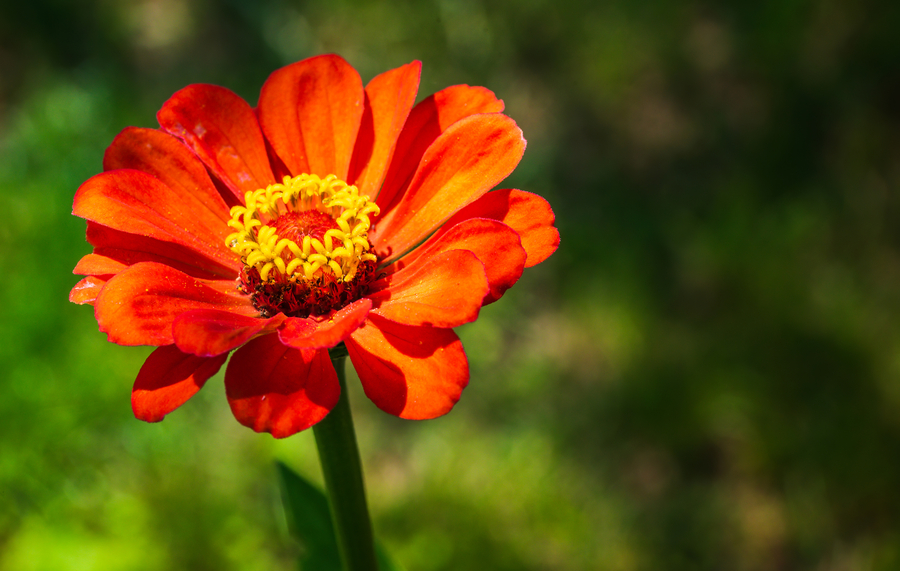
| Common name | Mexican sunflower |
| Botanical name | Tithonia rotundifolia |
| Family | Asteraceae |
| Mature size | 3 to 6 feet tall and 2 to 3 feet wide |
| Plant type | Annual |
| Native range | Mexico and Central America |
| USDA hardiness zone | 9a, 9b, 10a, 10b, 11a, 11b |
| Growth habit | Erect |
| Growth rate | Rapid |
Tithonia rotundifolia is a low-maintenance garden annual admired for its lovely flowers, which are also a source of attraction for pollinators and hummingbirds. These gorgeous flowers that start with T appear from mid-summer to fall, adding color to home gardens and landscapes.
Mexican sunflower thrives best in full sun locations and any soil type, making this plant ideal for both beginner and expert gardeners.
3. Trachelium caeruleum (Blue throatwort)
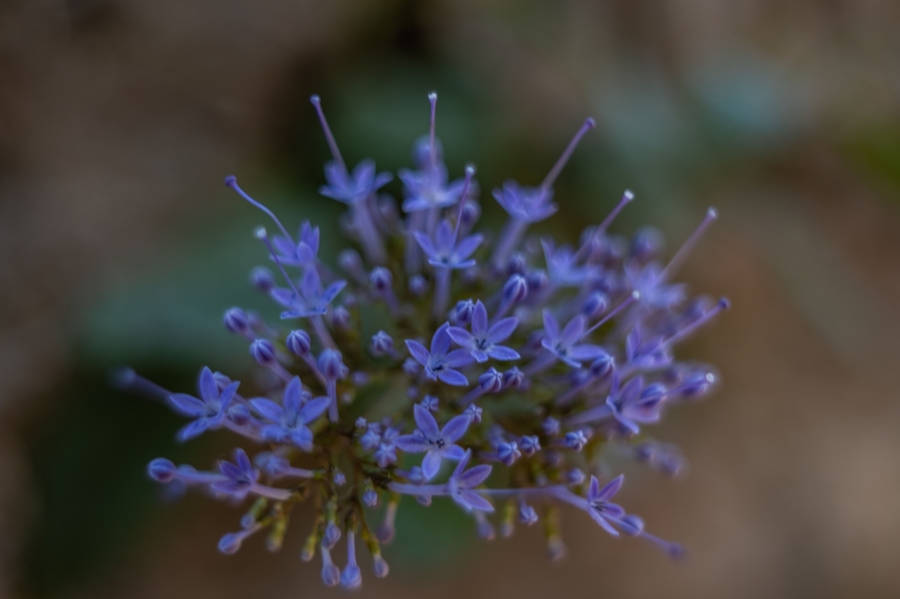
| Common name | Throatwort, blue throatwort |
| Botanical name | Trachelium caeruleum |
| Family | Campanulaceae |
| Mature size | 2-3 feet tall and wide |
| Plant type | Perennials |
| Native range | Mediterranean region |
| USDA hardiness zone | 9-13 |
| Growth rate | Moderate to fast |
| Growth habit | Erect, clump-forming |
With beautiful flowers, Trachelium caeruleum is a clump-forming herbaceous perennial of the Campanulaceae family. It offers small violet-blue flowers in domed clusters from early summer to fall and attracts many pollinators to cottage gardens.
It grows best in moderately fertile and well-draining soils with full sun exposure. West or east-facing windows are best for ideal sunlight when grown indoors as houseplants.
4. Trillium grandiflorum (Great white trillium)
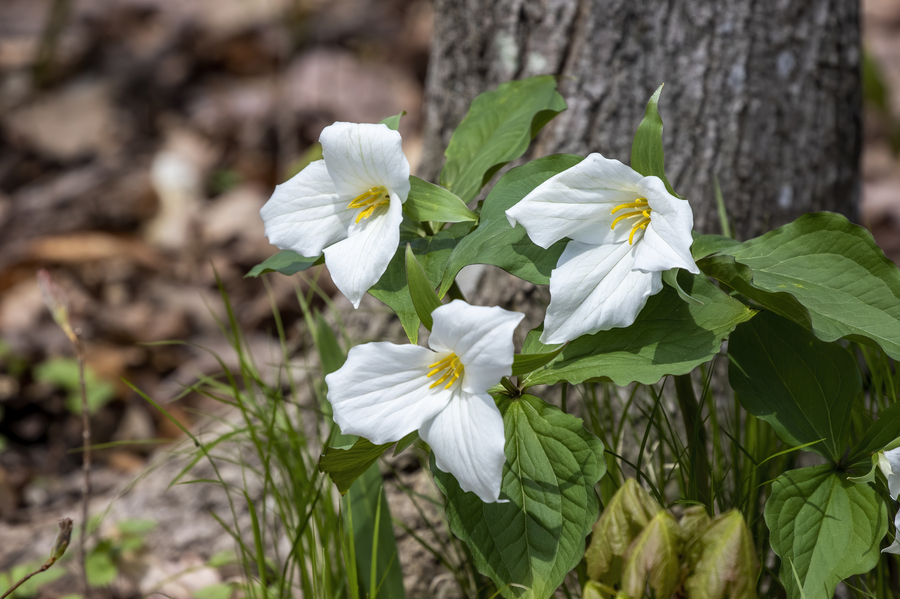
| Common name | Great white trillium, wake-robin, white trillium, large-flowered trillium, wood lily |
| Botanical name | Trillium grandiflorum |
| Family | Melanthiaceae |
| Mature size | Grows to a mature height of 1-3 feet and 1 foot wide |
| Plant type | Herbaceous perennial |
| Native range | Eastern North America |
| USDA hardiness zone | 4a, 4b, 5a, 5b, 6a, 6b, 7a, 7b, 8a, 8b |
| Growth rate | Slow |
| Growth habit | Spreading, erect |
Also known as wood lily and wake robin, Trillium grandiflorum is a herbaceous perennial with the showiest white flowers held atop glossy green leaves. It is native to woodland from Minnesota to Alabama.
It grows through an underground rhizome in spring and blooms from late spring to mid-summer. The ideal growth conditions for this stunning flowering perennial are humus-rich, well-draining soils and full shade locations.
5. Triteleia laxa (Triplet lily)
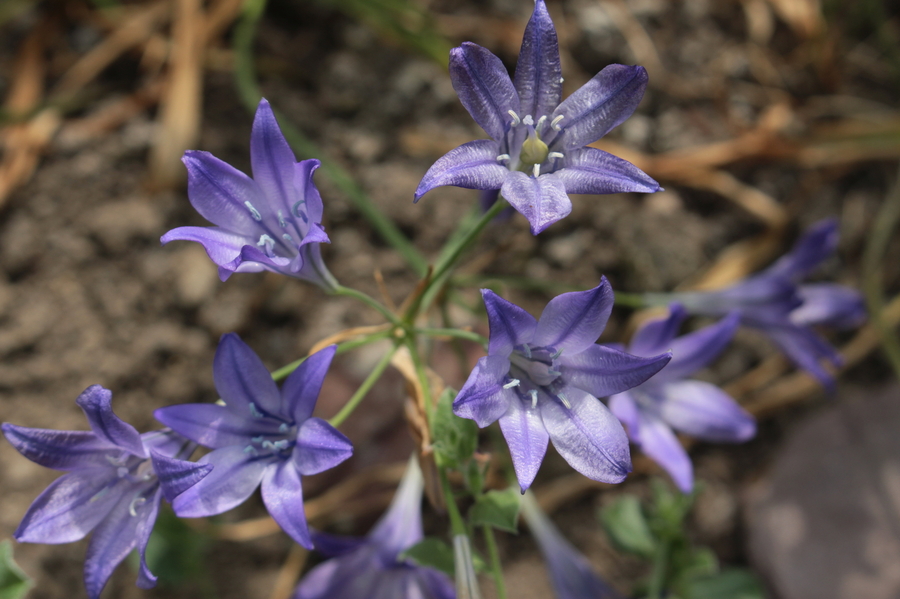
| Common name | Wild hyacinth, triplet lily, grass nut, long rayed triteleia |
| Botanical name | Triteleia laxa |
| Family | Asparagaceae |
| Mature size | Grows to 1 foot 3 inches in height and 1 foot 6 inches wide |
| Plant type | Bulb |
| Native range | Northern California |
| USDA hardiness zone | 5a, 5b, 6a, 6b, 7a, 7b, 8a, 8b, 9a, 9b |
| Growth habit | Erect |
| Growth rate | Slow to medium |
Long-rayed Triteleia (Triteleia laxa) is a herbaceous perennial of the Asparagaceae family. This herbaceous perennial is native to Northern California. It is grown from tubers or bulbs in rich, well-draining, sandy loam soils. Triplet lily blooms from early to late summer with consistent moisture and full sun for over 6 hours.
The flowers are purple / lavender and are borne atop lance-shaped leaves. In addition to its beautiful flowers that start with the letter T, this plant is low maintenance and easy to grow and maintain, making it a great pick for home gardens and landscapes.
6. Thymus vulgaris (Thyme)
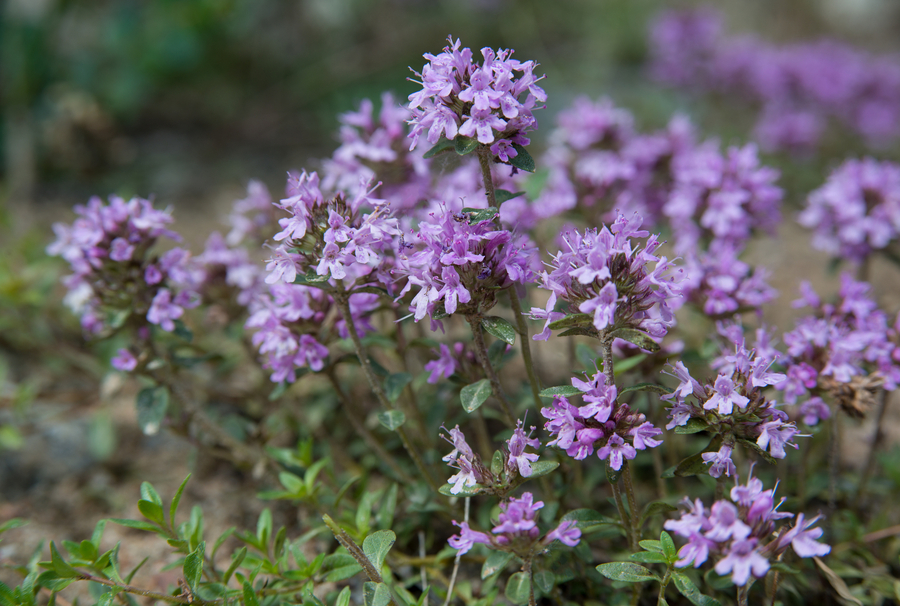
| Common name | Garden thyme, German thyme, common thyme |
| Botanical name | Thymus vulgaris |
| Family | Lamiaceae |
| Mature size | 6 inches to 1 foot tall and 1 foot wide |
| Plant type | Herbaceous perennial and ground cover |
| Native range | Europe |
| USDA hardiness range | 5a, 5b, 6a, 6b, 7a, 7b, 8a, 8b, 9a, 9b |
| Growth rate | Medium |
| Growth habit | Spreading |
Garden thyme (Thymus vulgaris) is the mint family’s low-growing, evergreen perennial. This plant originated in northern Africa and southern Europe and prefers to grow in dry, rocky soils. It is admired and grown for its creeping growth habit, stunning pink flowers, and medicinal properties.
With its showy and intensely fragrant leaves, garden thyme attracts pollinators and adds interest to the landscape.
7. Tigridia pavonia (Tiger flower)
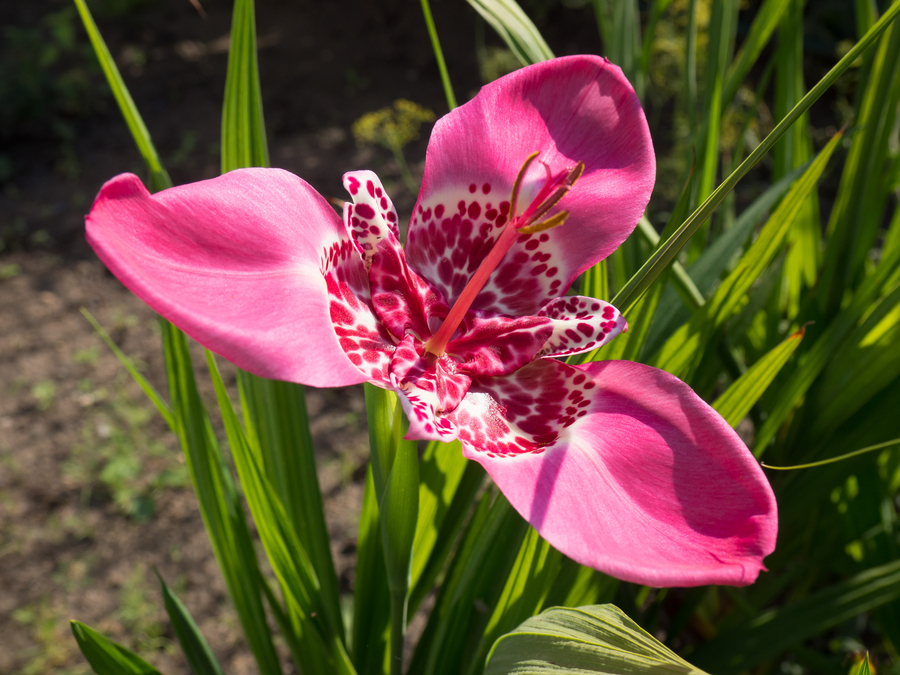
| Common name | Mexican shell flowers, tiger flowers, peacock flower |
| Botanical name | Tigridia pavonia |
| Family | Iridceae |
| Mature plant | Grows to a height of 1-2 feet and 4-5 inches wide |
| Plant type | Bulb |
| Native range | Mexico, South America |
| USDA hardiness zone | 8a, 8b, 9a, 9b, 10a, 10b |
| Growth rate | Medium |
| Growth habit | Erect |
Also known as the peacock flower or tiger flower, Tigridia pavonia is a unique-looking plant of the iris family. It offers two-toned, flared flowers in many shades of white, pink, red, orchid, yellow, and orange. These vibrant flowers appear in summer and last for several weeks. To enjoy the long blooming season, grow these plants in full sun and fertile soils.
The plant is hardy in the USDA hardiness zone 8 to 10 but can be grown and maintained as an annual flowering plant in climates below zone 7b.
8. Toadflax (Linaria spp.)
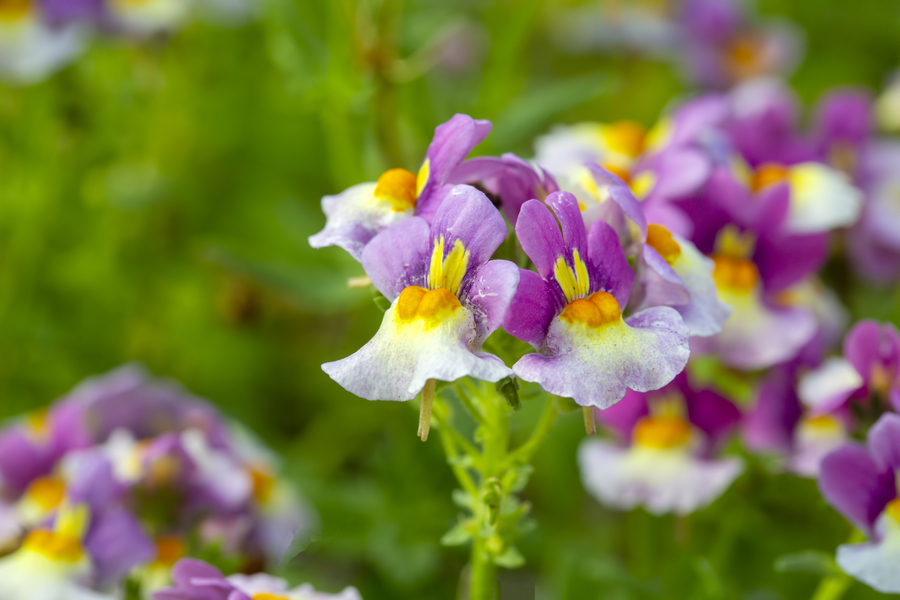
| Common name | Yellow toadflax, Wild snapdragon |
| Botanical name | Linaria vulgaris |
| Family | Plantaginaceae |
| Plant type | Perennial |
| Mature plant | 1-2 feet tall |
| Native range | Eurasia |
| USDA hardiness zone | 3a, 3b, 4a, 4b, 5a, 5b, 6a, 6b, 7a, 7b, 8a, 8b, 9a, 9b |
| Growth rate | Fast |
| Growth habit | Erect, spreading |
Linaria vulgaris is a perennial plant with snapdragon-like flowers from late spring to first frost. The bright yellow flowers are borne in terminal clusters on erect stems. They attract many pollinators, especially bees, butterflies, and hummingbirds.
The plant is a fast grower with a spreading growth habit. It grows to 2 feet tall with an underground spreading root system (that can extend to 10 feet, giving rise to new plants).
Yellow toadflax thrives best in full sun, moderately fertile, and well-drained soils. When grown in such ideal conditions, this hardy perennial continues to thrive year after year.
9. Trycyrtis spp. (Toad lily)
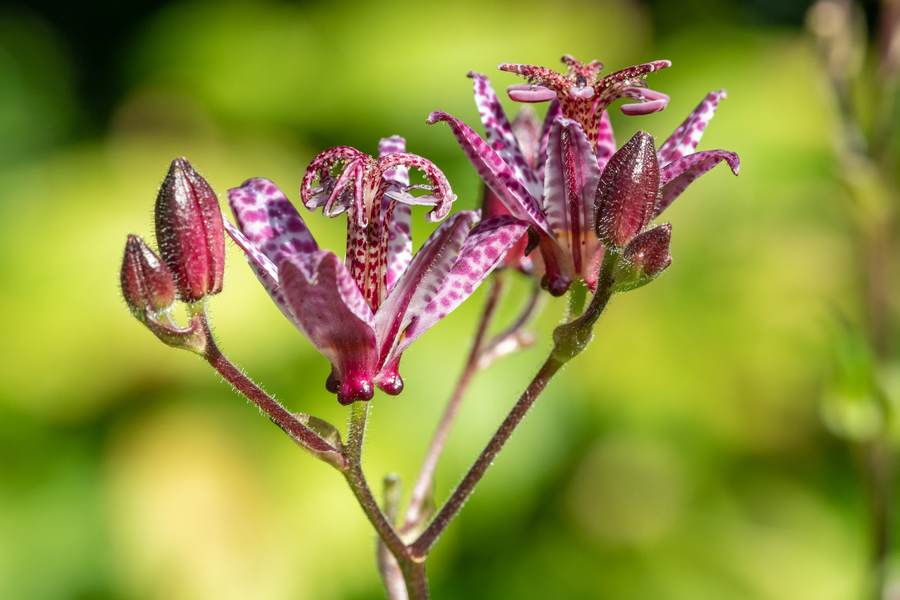
| Common name | Formosan toad lily |
| Botanical name | Tricyrtis formosana |
| Family | Liliaceae |
| Plant type | Perennial |
| Mature plant | Grows to 2-3 feet tall and 1-2 feet wide |
| Native range | Taiwan, China, Korea |
| USDA hardiness zone | 4a, 4b, 5a, 5b, 6a, 6b, 7a, 7b, 8a, 8b, 9a, 9b |
| Growth rate | Slow |
| Growth habit | Spreading |
Like hostas, toad lilies are shade-loving plants of the Liliaceae family. They offer small, orchid-like flowers (about 1 inch long) with six tepals sprinkled with purple freckles. These showy flowers appear in late summer to early fall and sit in loose clusters at the top of erect stalks.
The foliage is glossy, lance-shaped, and of dark green color, which complements the freckled flowers. In addition to their beautiful blooms, toad lilies are disease-resistant, low-maintenance, and easy-care plants.
Annual Flowers that Start with T
1. Thunbergia spp. (Bush clock vine)
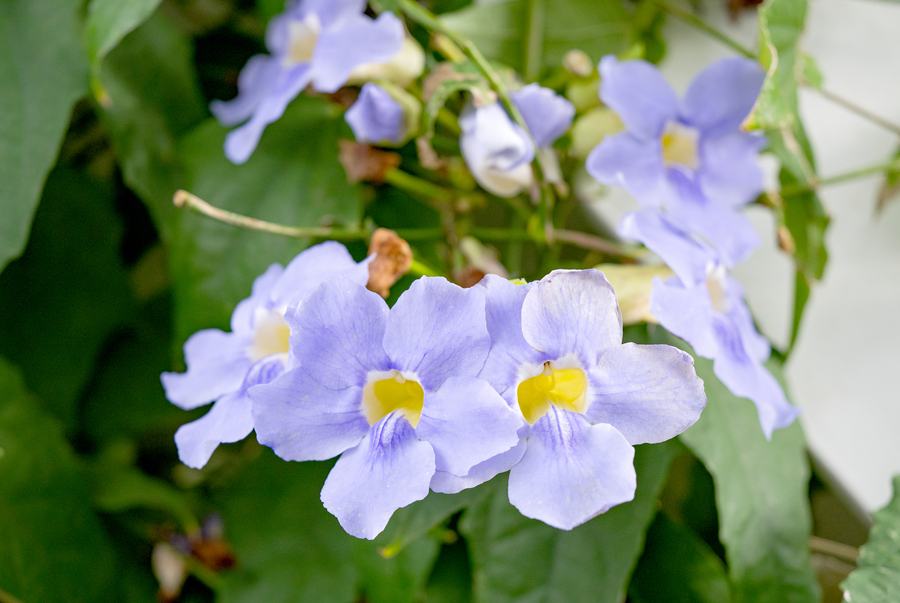
| Common name | King’s mantle, sweet clock vine, bush clock vine |
| Botanical name | Thunbergia erecta |
| Family | Acanthaceae |
| Mature size | 4 to 6 feet tall and 5 to 8 feet wide |
| Plant type | Annual |
| Native range | Tropical and South Africa, Madagascar |
| USDA hardiness zone | 10a, 10b, 11a, 11b |
| Growth habit | Cascading, spreading, climbing |
| Growth rate | Medium to fast |
Thunbergia erecta is a tropical evergreen annual admired for its ovate dark green leaves and dark blue to purple flowers with yellow throats. These velvety flowers appear throughout the summer and fall. They thrive in full sun to partial shade and well-drained soils.
For a powerful display of colors, grow these evergreen shrubs as hedges, summer garden beds, and Mediterranean gardens.
2. Torenia plant (Torenia spp.)
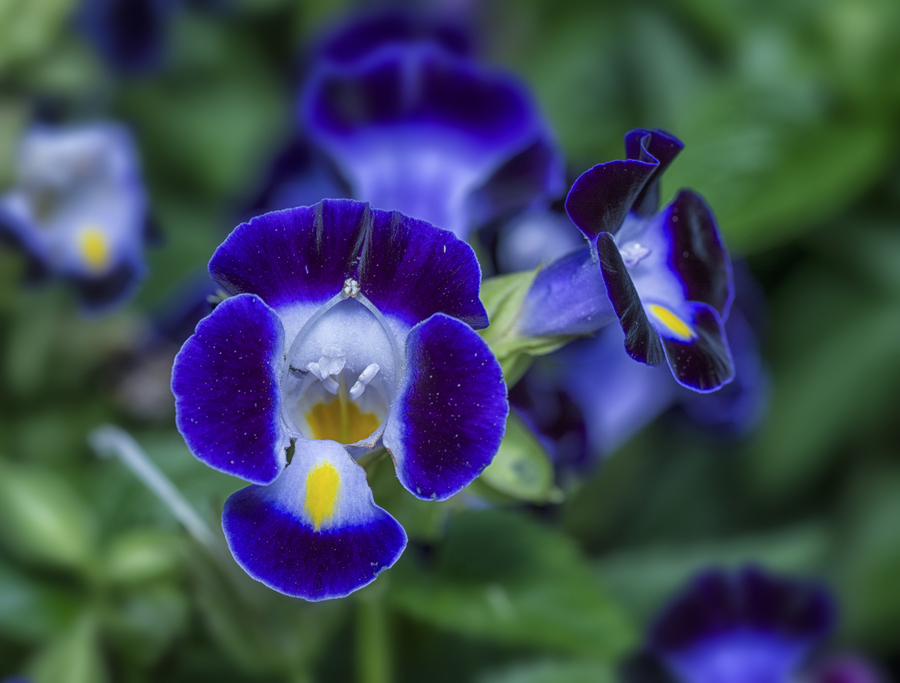
| Common name | Torenia plant |
| Botanical name | Torenia spp. |
| Family | Linderniaceae |
| Mature size | 6 inches to 1 foot tall and 6-8 inches wide |
| Plant type | Annual |
| Native range | Asia |
| USDA hardiness zone | 2a, 2b, 3a, 3b, 4a, 4b, 5a, 5b, 6a, 6b, 7a, 7b, 8a, 8b, 9a, 9b, 10a, 10b, 11a, 11b |
| Growth rate | Medium |
| Growth habit | Erect |
Torenia plants are shade-loving, yearly plants of the Linderniaceae family. They are perfect for adding color and interest to any garden theme with their two-toned blooms.
Use these flowers that start with a T in mass plantings, hanging baskets, and flower beds with begonias, caladiums, coleus, and Persian shield.
3. Tobacco plant (Nicotiana benthamiana)
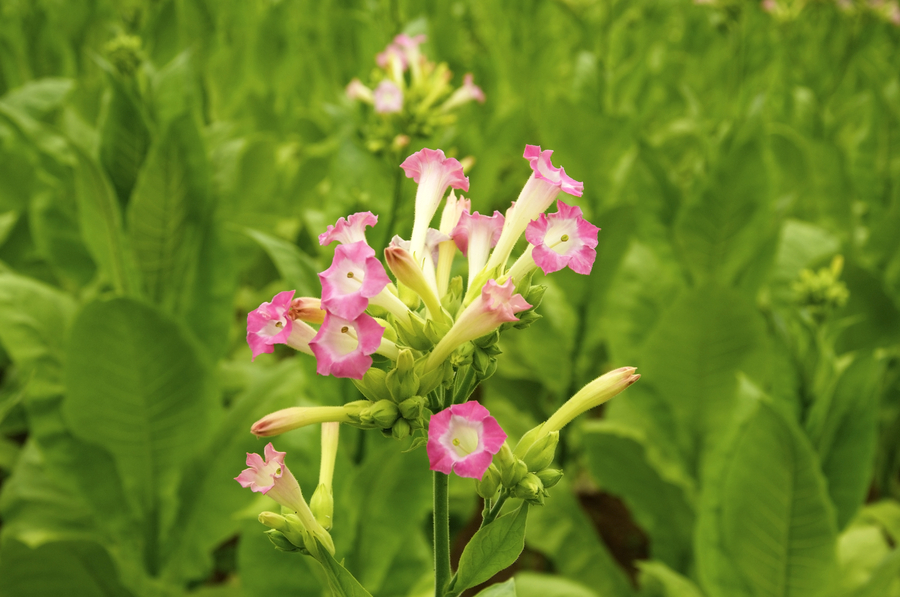
| Common name | Tobacco plant |
| Botanical name | Nicotiana benthamiana |
| Family | Solanaceae |
| Mature size | 4 to 6 feet tall |
| Plant type | Herbaceous annual, perennial |
| Native range | Australia |
| USDA hardiness zone | 9a, 9b, 10a. 10b |
| Growth habit | Erect |
| Growth rate | Fast |
Tobacco plants are tender perennials hardy to USDA hardiness zone 9 and 10. They are grown for their leaves, which are used in tobacco cigarettes, cigars, and snuff for pest management. They proliferate in full sun, moist, and well-draining soils.
Frequently Asked Questions (FAQ) About Flowers that Start with T
What are the most common flowers that start with the letter T?
The most common and easy-to-grow flowers that start with T are toad lilies, tiger lilies, toadflax, tobacco plants, and Thymus vulgaris.
What are some rare flowers that start with the letter T?
Some rare flowers that start with T are teasel, touch-me-not, tuberose, and turnsol.
Are there any pink flowers that start with T?
Here is a list of pink flowers that start with a T: Tulipa, Tecomanthe dendrophila, Tamarix (commonly known as Tamarisk), Tanacetum (the common name of this flowering plant is feverfew), and Tetradium spp.
Are there any exotic flowers that start with the letter T?
Exotic types of flowers that start with a T are Trycyrtis spp. (Toad lilies) and Tropaeolum spp. (commonly known as a flame creeper, canary bird creeper).
Are there any purple tall flowers that start with the letter T?
This list of purple tall flowers that start with T includes Torenia plants (trumpet-shaped flowers appear dark blue to purple), Thunbergia spp. (produces two-toned flowers that appear pale blue to purple with yellow throats) and Trycyrtis spp.
Image credit: Depositphotos
